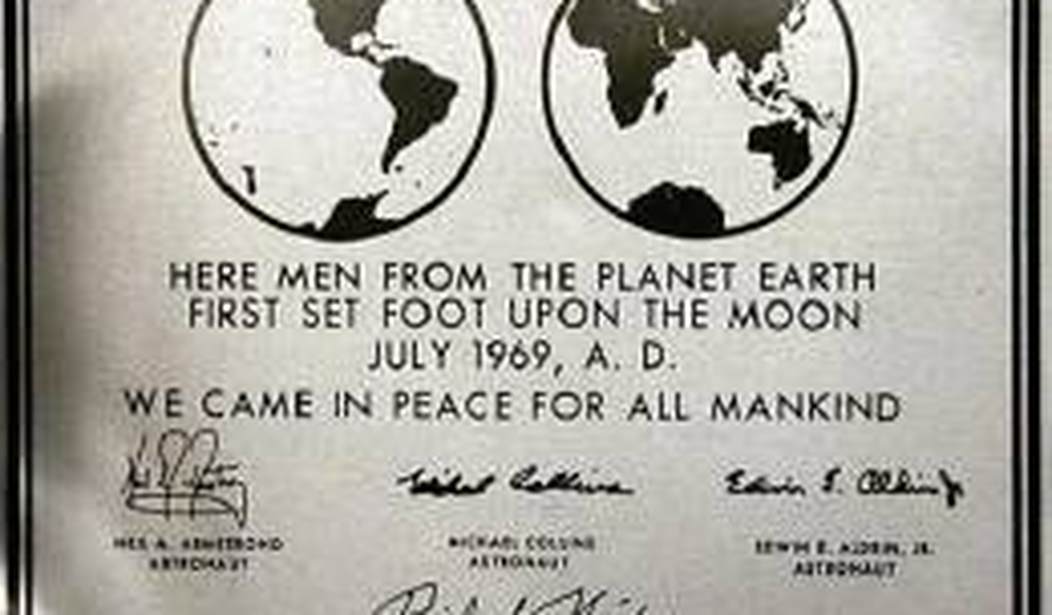The Landing, July 20, 1969
If I could go back, I would expect not only a larger room, but a longer moment to gaze at the stars and the cloudy blue ball that should only be mankind’s starter home.
NASA plans to go back to the Moon no later than 2020 and to begin building a permanent base by 2024. NASA’s project Constellation is now developing the hardware that will take us to the Moon. It is about time.
The sad fact is that no human being has ventured beyond low Earth orbit since 1972. The whole history of human exploration, outside the immediate vicinity of our planet, is confined to the Nixon years, from 1968 to 1972.
Today, the International Space Station is mankind’s one, fragile toehold in outer space. NASA is committed to finishing it before the shuttle is retired in 2010. By this time next year, after five more shuttle missions, the station will be fully equipped with solar arrays and will have another three pressurized modules attached. When it is done, it will be a place where we can test the technologies and systems we will need on the Moon and beyond.

NASA unveiled its plans for a base on December 4th, 2006. The lunar base is to be built on one of the Moon’s poles, probably the south one, which is lit by the Sun at least 75 percent of the time. “Our objective is to create a enduring sustainable human and robotic presence that will open up vastly greater opportunities for science, research and technological development,” Shana Dale NASA’s Deputy Administrator explained. The base will be manned by teams of astronauts who will rotate in and out every six months.
As it expands, scientists will be able to use it as a base from which they can not only explore the moon, but will be able to build a very large radio telescope on the far side where it will be able to observe the universe shielded from the electromagnetic pollution put out by our civilization’s relentless hunger for wireless bandwidth.
On the moon’s pitted face, facing the Earth, observation platforms could be built to scrutinize the home planet’s climate and geophysics. Telescope apertures can be made as large as necessary and their performance will eclipse the Earth observation satellites now in orbit. Using a network of very large distributed hyperspectral sensors, the Earth’s environment can be persistently monitored with an accuracy and scope far greater than is possible with today’s orbiting telescopes. Unlike most satellites in orbit, these sensors will be accessible to humans, making them easier to repair or improve.
The greatest potential prize on the Moon is energy. “If the world’s 9 billion in 2050 used energy at the rate that Americans to today… the world would have to generate 102.2 terawatts,” writes MIT Professor Daniel Nocera in the Fall, 2006 issue of the quarterly Daedalus. Considering that the world only generates 13.5 terawatts today, the future needs of humanity may be impossible to meet from purely terrestrial sources. Nuclear, hydro and wind power will just not be enough. Even if you are skeptical of human induced global warming theories, generating that amount of energy from coal or natural gas would create more pollution than we may be prepared to tolerate.
Solar power from space offers very large amounts of electricity from a non-polluting source. The two basic solutions: solar power satellites based in orbits around the Earth, probably in geosynchronous orbit 32,000 miles up and lunar solar power beamed directly from the Moon to the Earth’s surface.
“Clever ideas have been advanced for the phased construction of electrical power sources – perhaps using solar cells manufactured in situ from Lunar soil. A not unreasonable scenario is a phase of highly subsidized capital construction followed by market-driven industrial activity” said Dr. Robert Marburger, the President Bush’s science advisor, in March 2006.
The idea of diverting the Sun’s rays to power our increasingly electric world has a long history in space science literature.
The first serious space solar power proposal dates from 1968 when Peter Glaser of Arthur D. Little published “Power From The Sun, Its Future” in Science magazine. It would gather electricity from photovoltaic panels and transmit it via microwaves or lasers to receiver antennas on Earth. In 1972 Gerald O. Neil led a study that designed a space colony circling the L-5 Lagrange Point. There are five of these Lagrange points “where all the [gravitational] forces are exactly balanced. When a spacecraft is placed at one of these points, it will stay there forever,” Neil wrote.
In a 1981 report, the Congressional Office of Technology Assessment explained “The basic premise of the non-terrestrial materials option is that the cost, energy and materials requirements, and environmental impact of lifting the enormous cumulative masses needed to establish and operate a system of many satellite power stations off the Earth can be markedly reduced by using first lunar materials, and eventually materials obtained from asteroids. The fundamental physical principal that supports this premise is that it takes over 20 times as much energy to launch an object to geostationary orbit from the Earth as it does from the Moon, … The primary drawback is the high ‘upfront’ cost of establishing the necessary mining base on the Moon….”
Since these proposals were made the technology for space solar power has improved considerably, a 5000 megawatt array designed with 1989 technology would have been only 35 % as large as one designed in 1979. Improvements in solar cell technology since then indicate that today a solar power satellite would be even smaller and less costly.
“About 13,000 terawatts of solar power hit the Moon,” notes Dr. David Criswell, an expert on lunar solar power. Obviously if we only capture and send a small portion of that down to Earth we will have changed forever the nature of the Earth’s energy economy.
It may be easier to build power stations on the Moon since they would not need the orbit keeping thrusters required by satellites. Maintenance by humans would also be easier in the low gravity of the Moon rather than in the weightless environment of orbital space.
A base on the Moon does not have to be a permanent government-controlled and owned facility. After it has been fully established, control could be handed over to a private non-profit consortium that would lease space to companies and governments which will then pursue their individual goals, such as energy, research, tourism, or developing the technology and supplies needed for further space exploration.
Handing off control of the base to a private group means that we will have to establish rules explaining what exactly is and is not private property on the Moon. According to the Outer Space Treaty, the Moon is “common heritage of mankind”. No one has ever been able to agree on exactly what this means, but few space law experts outside the United States seem willing to accept the idea that there is room for private entities to claim any sort of recognizable property rights on the Moon. The best they are willing to concede are long term leases with the rent being paid to the United Nations.
Still possession is nine tenths of the law. An American moon base would insure that traditional American ideas such as private property and homesteading would influence the future legal regime. Otherwise the Europeans and others might try and push their model of tight government control and high taxes onto the off-Earth economy of the late 21st century. Such an environment would stifle the creative endeavors not only of American entrepreneurs such as space ship one financed by Paul Allen, built by Burt Rutan, that forms the basis for Virgin Galactic’s suborbital space tourism project.
Greg Allison, Chairman of the National Space Society’s Policy Committee states that it “believes that the 1967 Outer Space Treaty can be interpreted as permitting public and private entities to appropriate resources that they can directly utilize and to establish a ‘reasonable’ zone of operations around sites of activity.” An American base, even one with substantial international participation, would create a precedent that would not only apply to the Moon but to all the other accessible bodies in our solar system.
After the Shuttle is retired in 2010, the only access to the International Space Station will be with the Russian Soyuz. This will last until Project Constellation’s Orion capsule is ready or until U.S. private companies are ready to take up the challenge. The length of this gap will be determined by how much funding NASA receives in the next couple of years. Trying to accelerate the development process with extra funds in 2011 or 2012 would be wasteful and perhaps dangerous.
NASA is already preparing to abandon its role as the sole American provider of crew and cargo transportation to and from low earth orbit. The Commercial Orbital Transportation System contracts, won by the small space companies SpaceX and Rocket Plane Kistler may provide transport to and from the International Space Station for cargo and (perhaps) passengers sometime early in the next decade. This will allow NASA to concentrate on exploration beyond Earth’s orbit and leave the taxi and transport business to private enterprise. That’s a good thing.
The greatest reason to send people back to the Moon is educational. No one disputes our nation’s need for large numbers of scientists and engineers. Today’s cultural environment too often fails to excite the next generation to study hard-sciences and engineering. Human space exploration proved to be inspiration for many in 1960s and 1970s and it could be again.
In a October 2005 report urging Britain’s participation in International human spaceflight the Royal Astronomical Society pointed out: “There is compelling evidence that the outreach potential for human space exploration can be a strong positive influence on the interests and educational choices of children.”
This from a group whose previous hostility towards manned missions had been notorious.
Astronauts may not be the great celebrities that they were in my time, but every time they visit a school or talk to a youth group about the importance of science, technology engineering and math, they are opening minds to new frontiers and fresh career choices.
The final reason to return to the moon is the ultimate one – survival. If humanity is confined to a single planet, our chances of a free, prosperous an environmentally friendly future are just dreams.

Buzz Aldrin is the second of 12 men to walk upon the surface of the moon. A West Point graduate and a Korean War fighter pilot, Aldrin joined the Astronaut corps in 1963 after earning his PhD from MIT with a thesis on Orbital Rendezvous. He first flew into space in 1966 on Gemini XII with James Lovell. In 1969, along with Neil Armstrong and Michael Collins he flew to the Moon on the historic Apollo 11 mission. He was the second man to walk on the moon. He retired from the Air Force in 1972 and is currently the Chairman of the Sharespace Foundation and the CEO of Starcraft Boosters.
Taylor Dinerman writes a weekly column for the Space Review [] and has written on space and defense issues for the Wall Street Journal ,National Review, Ad Astra the magazine of the National Space Society, Space News, and elsewhere. He was an author of the textbook Space Science for Students and is a consultant for the U.S. Defense Department. His views in no way represent those of the Department.









Join the conversation as a VIP Member